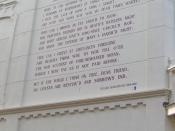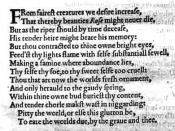Sonnet 73
Sonnet 73 gives an insight into a particularly emotional time in William Shakespeare's life.
William Shakespeare, who lived during the second half of the 16th century and the early 17th century, wrote sonnet 73 to an anonymous lover. The sonnet discuses themes of time, love and finally death. The sonnet uses AB AB rhyme, meaning that the first line rhymes with the third, whilst the second line rhymes with the fourth
Sonnet 73 is divided into three quatrains, summarising the poem with a couplet at the end. There is a progression of time decline throughout the sonnet. The first quatrain is a season, the second a day and the third the few hours it takes for a fire to burn out. The theme of the sonnet is that love is stronger than time and physical decay, but does not survive death. In this sonnet, the poet compares himself to three different things, the first being a tree in the autumn;
"That time of year thou mayst in me behold
When yellow leaves, or none, or few, do hang"
"Thou", meaning "you", represents the love of the writer's life of which there were two; the Dark Lady and the Young Man.
The poem takes place in the autumn of his life. This contrast shows the stages of his life, his mid-life. The word "boughs", bare branches, also implies that it is autumn. The metaphor "ruinôd choirs" in line four, means the tree, which in summer birds had sung on, but the bringing of autumn took the life from the tree.
The words "twilight of such day", in line five, the beginning of the second quatrain, represents the evening of the writer's life. "Sunset fadeth" explains how once the sun has gone down, all he has to look forward...


